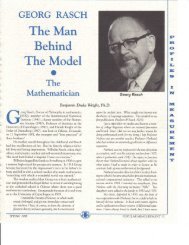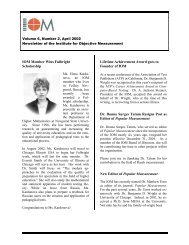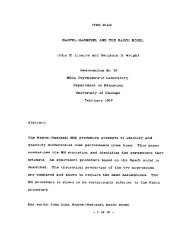a Definition of
a Definition of
a Definition of
You also want an ePaper? Increase the reach of your titles
YUMPU automatically turns print PDFs into web optimized ePapers that Google loves.
Toward a <strong>Definition</strong> <strong>of</strong><br />
Sexual Harassment'<br />
in the Workplace<br />
Suzy Vance JD, LL.M.<br />
Anne Wendt, PhD, RN<br />
Introduction<br />
Reports <strong>of</strong>sexual harassment on thejob are on the rise nationwide .<br />
Employers are seeking strategies to decrease and prevent sexual harassment .<br />
Thisreport is based on: 1) training work sessions intended to increase partici<br />
pants' self-awareness and appreciation <strong>of</strong> others, and 2) assessment <strong>of</strong> shifts<br />
in participants' attitudes and awareness with respect to potential sexual harassment<br />
behaviors . The unique work sessions consisted <strong>of</strong>.<br />
1) presentation and discussion <strong>of</strong>information about whatconstitutes<br />
sexual harassment,<br />
2) group activities intended to raise awareness <strong>of</strong> selfand others,<br />
and<br />
3) presentation <strong>of</strong> scenarios portraying common work situations<br />
using live actors and volunteers from among the participants<br />
to build skills for managing human interactions in the workplace<br />
.<br />
Methodology<br />
Participants were asked to complete a survey assessing sexual issues/harassment<br />
before and after the work sessions . After a review <strong>of</strong> the<br />
literature and legal cases relating to sexual issues/harassment, the authors<br />
developed a theory about how sexual issues/harassment might be manifested<br />
in the workplace . Table 1 illustrates the spectrum <strong>of</strong> potentially problematic<br />
behavior in the area <strong>of</strong>sexual issues/harassment.<br />
Table 1 .<br />
Spectrum <strong>of</strong>Behavior<br />
Visual Verbal Written Touching<br />
Staring Requests for dates Love letters Violating space<br />
Posters Lewd comments Obscene letters Patting<br />
Magazines Sex jokes Cards Grabbing<br />
assault<br />
Calendars Questions about E-mail Caressing<br />
personal life Fax Kissing<br />
Fondling<br />
Power<br />
Using position to insist on<br />
dates and other things<br />
Promising<br />
Threatening with negative<br />
impact on job<br />
Force<br />
Rape<br />
Physical<br />
* This survey instrument, an Interfocus® Survey - Human Interaction in the<br />
Workplace #1, has been registered with the Copyright Office <strong>of</strong> the Library <strong>of</strong> Congress<br />
by Susan Vance . .E<br />
SPRING 2000<br />
Suzy Vance<br />
Over the years Suzy, with her common sense and<br />
sensitivity to diverse perspectives, engaged in an extensive<br />
and successful law practice focusing on human<br />
relationships at work - including the presentation <strong>of</strong> a<br />
prevailing argument to the United States Supreme Court .<br />
Today Human Interaction is her business . Her work<br />
with groups and organizations is based on her fundamental<br />
belief that: "People make the difference in all we<br />
do ."<br />
Suzy <strong>of</strong>fers services in three areas: Interfocus®<br />
building strategies for human interaction in the workplace<br />
while addressing specific concerns . Partnership<br />
Connection ® - bridging the gap from school to community<br />
through inter-generational programs in elementary,<br />
middle and secondary schools . Team-building -<br />
Bonding and strengthening groups and rewarding people<br />
for jobs well done - including Life Mask' .<br />
POPULAR MEASUREMENT 55
Instrument Development<br />
A survey intended to illicit honest responses from participants<br />
regardingsexual issues/harassmentwas developed. Participants<br />
were asked to respond to statements using a likerttype<br />
scale in the following areas : jokes, flirting, dress and<br />
attraction, touching, patting, hugging, and backrubs .<br />
The survey began with "easy-to-agree with" statements<br />
that are playful and engaging. The statements become<br />
"harder-to-agree with" and more riskyand dangerous forwork<br />
place behavior. For example, it is "safe" and "easy-to-agree<br />
with" the statement "I laugh at goodjokes ." It is "riskier" and<br />
"harder-to-agree with" the statement "I like to tell sex jokes."<br />
Similarly, it is logical that it is "safe" and "easy-to-agree with"<br />
the statements "I like back rubs" and "I like getting back<br />
rubs." It is "more risky" and "harder-to-agree with" the statement<br />
"Backrubs at work are ok ."<br />
An example <strong>of</strong>how the statements were formatted<br />
in the survey is as follows :<br />
1 . I enjoy sex jokes. SA A D SD<br />
2 . I tell sex jokes . SA A D SD<br />
3 . Sex jokes are ok, SA A D SD<br />
as long as they<br />
don't stop work .<br />
SA = Strongly Agree, A= Agree, D = Disagree, SD = Strongly Disagree<br />
Data Collection<br />
For reasons peculiar to the project, demographic<br />
information was not collected . There is no information as<br />
to the differences in response, if any, between men and<br />
women, various levels within the department, or racial or<br />
ethnic distinctions . There also is no information as to the<br />
movement on the spectrum or shift in responses for individual<br />
participants because responses were not tracked individually.<br />
Without demographic information, the results<br />
reported here represent only a beginning definition <strong>of</strong> the<br />
variable "Sexual Issues/Harassment ."<br />
Surveys were distributed to 216 participants before<br />
training. One hundred and eighty five <strong>of</strong> the 216 employees<br />
attended the first work session . One hundred one (55%) <strong>of</strong><br />
the 185 participants turned in the "before" survey. One hundred<br />
sixty seven <strong>of</strong> the 216 employees attended the second<br />
work session . One hundred eleven (66%) <strong>of</strong>the 167 completed<br />
the "after" survey. Twenty six (12%) surveys were<br />
determined to be invalid . One hundred eighty six surveys<br />
were analyzed to determine the definition <strong>of</strong>the variable .<br />
Data Analysis<br />
Data were analyzed using the Rasch partial credit model<br />
with WINSTEPS . Data which did not fit the model were<br />
not used as part <strong>of</strong>the definition <strong>of</strong> the Sex Issues Construct.<br />
56 POPULAR MEASUREMENT<br />
Results<br />
The responses to the before-and-after surveys<br />
were pooled to create the Sex Issues Construct shown in<br />
Table 2 . Analysis <strong>of</strong> the data shows that responses fell<br />
into three categories - statements that were<br />
1 . 'SAFE - Easiest to agree with - more than 50% agreed<br />
2. RISKY - Easier to disagree with - more than 50%<br />
disagreed<br />
3. DANGEROUS - Very Much Easier to disagree with -<br />
more than 67% disagreed<br />
Table 2. Sex Issues Construct<br />
SAFE - Easiest to AGREE with<br />
I laugh at good jokes .<br />
Jokes at work are ok .<br />
How much I enjoy being hugged, depends on the<br />
circumstances .<br />
When I kid around, I might pat someone on the back .<br />
I like to tell jokes .<br />
When I congratulate someone, I pat them on the back .<br />
It's ok to hug a co-worker .<br />
I like back rubs .<br />
I like getting back rubs .<br />
I like to hug.<br />
Sometimes I touch people without knowing it.<br />
When I'm excited, I might hug.<br />
RISKY - Easier to DISAGREE with<br />
When someone wears an outfit, I may stare at them.<br />
When someone dresses in an appealing way, I like to tell<br />
them .<br />
I like to touch people .<br />
It's ok to hug the boss .<br />
Whether I enjoy a sex joke, depends on who tells it.<br />
I enjoy sex jokes .<br />
Touching at work is ok .<br />
When I see something I want, I go after it.<br />
I like giving back rubs .<br />
I enjoy flirting.<br />
DANGEROUS : Much Easier to DISAGREE with<br />
Worrying about "not touching" is silly.<br />
Flirting at work is ok .<br />
Sex jokes are ok at <strong>of</strong>fice parties .<br />
When I thinksomeone is good-looking, I let them know.<br />
Sex jokes are ok, as long as they don't stop work .<br />
WhenI'm attracted to someone, I'm not afraid to tell them.<br />
Flirting is ok as long as it doesn't stop work .<br />
When I want to go out with someone, I ask them.<br />
Flirting isharmless .<br />
Flirting never makes me uncomfortable .<br />
I tellsex jokes.<br />
I like to flirt at work.<br />
Back rubs are ok at work .<br />
When someone is good looking, I can't stop lookingatthem.<br />
When I kid around, I might pat someone on the rear.<br />
SPRING 2000
For example, statements about flirting were<br />
"harder-to-agree with" and thought to be risky and dangerous<br />
. It was "hardest-to-agree" that patting someone<br />
on the rear is ok . "Patting on the rear" is the most dangerous<br />
<strong>of</strong> all identified interactions and borders on the<br />
more overt end <strong>of</strong> the behavior spectrum constituting<br />
portential sexual harassment .<br />
(Note : This does not mean there should be a rule<br />
.against getting or giving back rubs or hugs at work,<br />
flirting at work, or even patting someone on the rear.<br />
What the Sex Issues Construct does show is attitudes<br />
toward certain behavior fall in a logical or commonsense<br />
progression frommost "safe" to most "dangerous."<br />
This information can be used to measure shifts in awareness<br />
and appreciation or attitude . It also can be used to<br />
raise awareness <strong>of</strong>the progression<strong>of</strong>behavior and teach<br />
skills to avoid or stop the progression when it becomes<br />
important to prevent behavior from crossing the line<br />
from "safe" into "risky" and "dangerous" areas .)<br />
As can be seen in Table 2, the goal <strong>of</strong>the authors<br />
<strong>of</strong> determining the Sex Issues Construct was achieved.<br />
Those statements on attitudes and behaviors which were<br />
intended to be "easy-to-agree with," such as "I laugh at<br />
good jokes," have indeed calibrated to be safe and "easyto-agree<br />
with ." Those statements which were intended<br />
to be "harder-to-agree with" such as "I tell sex jokes" and<br />
"Backrubs at work are ok" have indeed calibrated to be<br />
"dangerous" and "more difficult to agree with."<br />
Conclusions<br />
The initial definition <strong>of</strong> the Sexual Issues Construct<br />
essentially has been realized .<br />
There were several statements on the survey that<br />
did not fit the Rasch measurement model . They were not<br />
used in the definition <strong>of</strong> the Sex Issues Construct . These<br />
statements will need to be revised as the definition <strong>of</strong>the Sex<br />
Issues Construct is refined . Some statements also did not fit<br />
within the Sex Issues Construct as the authors <strong>of</strong> the survey<br />
anticipated. For example, "Flirting never makes me uncomfortable"<br />
was not thought to be one <strong>of</strong> the statements most<br />
"hard-to-agree with ." The use <strong>of</strong>the modifying word "never"<br />
in the statement may have contributed to this unanticipated<br />
result . Additional statements also need to be created to fill in<br />
gaps and expand the continium <strong>of</strong> the Sex Issues Construct .<br />
For the latest<br />
in Rasch<br />
measurement<br />
s<strong>of</strong>tware,<br />
visit<br />
www.winsteps.org<br />
Anne Wendt<br />
Anne Wendt is the NCLEX Content Manager at the National<br />
Council <strong>of</strong> State Boards <strong>of</strong> Nursing, a not-for-pr<strong>of</strong>it<br />
organization responsible for the development <strong>of</strong> the National<br />
Council nursing licensure examination (NCLEX Examination) .<br />
She received her BSN from the University <strong>of</strong> Minnesota, her<br />
MSN from Loyola University, and her Ph .D. in Psychometrics<br />
from the University <strong>of</strong> Chicago .<br />
Anne Wendt has a unique perspective <strong>of</strong> nursing licensure<br />
exams because she comes to her position as a nurse, a psychometrician,<br />
and as an educator. She was instrumental in the<br />
National Council's transition from a paper-and-pencil NCLEX<br />
examination to its current computerized adaptive testing (CAT)<br />
form . She has co-authored the NCLEX test plans and detailed<br />
test plans since March 1993 . She has also been influential in the<br />
publication <strong>of</strong> such documents as The NCLEX'" Process, The<br />
NCLEX- Manual and Assessment Strategies for Nursing<br />
Educators .<br />
SPRING 2000<br />
POPULAR MEASUREMENT 57









